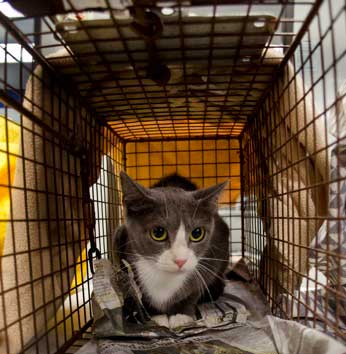T • N • R
Click the headers below for more info
- Baiting and setting the traps in a safe location, using as many traps as there are cats in the colony needing trapping.
- Waiting nearby but out of sight for cats to enter the traps and the traps to close.
- Quickly covering each occupied trap with a cover or sheet, which helps to calm the cat within.
- Checking whether each trapped cat is already owned or neutered (e.g., via ear-tip marking, identification tattoo or microchip, and lost-pet databases and ads; attempting to contact owners in the case of stray pets.
- Carefully releasing any accidentally trapped wildlife.
- Safely transporting the cats in their traps to the clinic or holding area.
- Trying alternative traps and methods in the case of unusually wary cats.

- Providing extra care for cats not yet ready for surgery. Cats in poor condition may receive additional medical attention, and be well-fed to gain weight and strength before surgery. Young kittens may be socialized in foster care, which prevents their becoming feral. Nursing mother cats may be kept with their kittens (and even other orphaned kittens) until the kittens are weaned.
- When ready, a veterinarian performs spay or neuter surgery and provides other medical attention as needed. Multiple surgeries may be done in high volume clinics.
- During the surgery of feral cats, ear-tipping (removing 3/8 inch or 1 cm from the tip of the left ear; proportionally smaller in a kitten) identifies that the cat has been neutered and treated, when later seen from a distance.
- Vaccinations are provided as arranged in advance. Common vaccines include rabies, FVRCP, panleukopenia ("distemper"), and respiratory-virus vaccines, though this will vary by program.
- Cats found suffering with terminal or untreatable illnesses or injuries are humanely euthanized.
- When the vet deems that the cats are ready to leave the clinic, they are taken to the recovery area, and monitored for at least 24 hours.
- If needed, the cats may receive additional care (e.g., medications, or more recovery time from complex surgery such as amputation).
- If the original colony location is safe, the treated cats are transported there and safely released from their traps or carriers.
- If the location is not safe for feral cats, other arrangements are made, e.g. for farmyard homes.
- Tame cats and (especially) kittens are placed in foster care until they are adopted. If there are insufficient resources to foster or shelter, the cats may be returned to outdoor colony locations in the same manner as feral cats.
- Detailed records are kept of the cats assisted, and the traps and other materials used are regularly cleaned.
- Caregivers monitor the outdoor colony locations, providing food, shelter, and medical care, and watch for any new abandoned cats requiring trapping. Some communities with "feral freedom" programs return cats without ongoing monitoring by caregivers.

